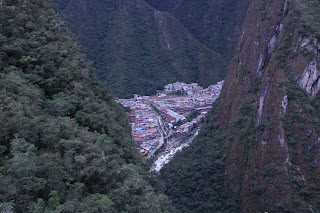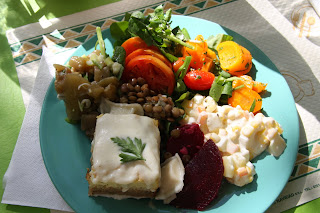
Having scoffed down a street-side “milanesa” (supposed to be a breaded filet, but it was more like a hamburger) I got on the bus to Sucre and instantly realised that we had been conned into a cama price, despite only having just enough room for my legs (heaven help my travelling partner Alistair who is over six foot).
The bus driver was still outside spruiking our departure, trying to fill the last remaining seats – one of which happens to be next to me. Of course I prayed that he had no luck, but this is Bolivia, and my little white-girl Australian wishes don’t mean anything at all here. (And so starts the worst bus ride in the world).
Never mind the Death Road, this was Death itself. Once we got driving, fluoro lights blinded us throughout the night, and the driver made sure that even the passing cars could hear his horrible Bolivian music. Not only just the seats, but the aisles were crowded with people and their parcels – which had been stuffed into whatever space they could find above and below. The familiar horse blanket smell of my tour returned in full force, and I clamoured to spray enough perfume on my clothes to overpower it.
Our first stop was after only a few hours for a “baño” (toilet) break, but we ended up staying much longer than the usual 15 minutes, with the drivers sitting down to eat dinner and chat with their other driver friends. Needless to say I didn’t sleep at all between Uyuni and Potosi and when we arrived at the highest city in the world – 4060m above sea – it was not only my heart that was agitated. Here we were told to get off with everyone else, who were staying in town to make the passage down the infamous silver mines, despite paying for an onward ticket to Sucre. Of course I questioned the driver further, as to the location of our next bus, and he mumbled something about it being around the corner. But was 130am, pitch black and my lungs could hardly breathe from the altitude and the diesel fumes that were being pumped out of our bus. I was in no mood for being fobbed off.
So I stood my ground and asked him again firmly, proving that my Spanish was not as bad as he thought it was, to which I was told to get back on the bus. Still not sure what was happening, Alistair and I were taken around the corner, where the bus stopped again. It is here that I asked the only other person with us, a young Bolivian guy, where he was going and what was happening. He politely told me he lives in Sucre and that a bus will come along eventually, but that it might take a few hours. I then probed further and asked how much he had paid to get there, to which he gave me a figure more than half ours.
I am livid at this stage, having been lied to about the price and the timing of our journey, and instantly thump on the driver’s door to demand some answers. I still don’t get any, but when bus passes a half an hour later, we are pushed through to the front, probably given someone else’s seats.
Aboard, we are greeted with an even more potent stench than before – matured over several hours no doubt – but fortunately no lights or music. I slowly drift in and out of consciousness, each time praying for the two hours to pass quickly, but it is almost 5am before we reach the terminal in Sucre, and my hopes of getting an early connection to Santa Cruz are immediately dashed when I find the terminal all closed-up except for the many waiting passengers. And I am further crushed when I see that no buses will leave until the afternoon.
So stumbling up the hill and around the corner with Alistair, I go to the closest hostel, and check in for a hot shower and a few hours sleep. Waking up a short while later, I go to buy my bus ticket out and join Alistair for a walk into town. But there’s really not much to see here – in a town of only 200,000 – bar a few closed museums and churches. And with Sunday siesta in full swing, sampling some chocolate is all that I have to fill in my time.
It is then that I call my friend in Santa Cruz to explain I won’t be arriving for her party that night, to which she tells me about the cheap flights here. And it is with this glimmer of light, that I jump online to book a ticket. But this doesn’t work, with only international flights appearing, so I head to the office in town to purchase one there. But they are closed too, any given Sunday, and I am told that I must go out to the airport itself - which I do with much urgency.
Once there, I am told there is one available in an hour or so, if I don’t mind going via La Paz rather than direct, and that they will reserve my ticket while I collect my bag and passport. So I haul my arse into a taxi, paying the high tariff just to get out of here, but when I return it seems things aren’t so easy after all. The group of French in front of me are politely informed that there are no phone lines out of the airport at the moment, and that the credit card machine won’t work. Of course nothing changes in the time it takes them to scrape together enough cash – there being no ATMs here either – and I am left with only one option. Suddenly it seems there is another seat on the direct plane, and I am told to take another expensive taxi to the their office in a downtown supermarket to pay there.
I quickly do this, but it is the same story there - there is no line out, and I must pay in cash. But time and money has gotten the better of me, having already missed the bus I tentatively booked, and being a low cash position for the next week, I cannot afford to pay in Bolivanos. And so I must return to the airport again, just to collect my bags and tell them that I can’t fly.
Once there, I try to arrange a payment in Santa Cruz, but it won’t work, and it seems I am stuck here until tomorrow, when hopefully, I will find a machine that works. Completely crestfallen, and not wanting to get back on the dreaded Death Bus, I walk back out the front of the airport where a sign stares back at me: “Sonrisa – estas in Sucre!”…Smile – you are in Sucre!
I think not.
(The next day I did of course get on a flight...but no, I wasn't game enough to eat the pork-laced empanada on board)

























